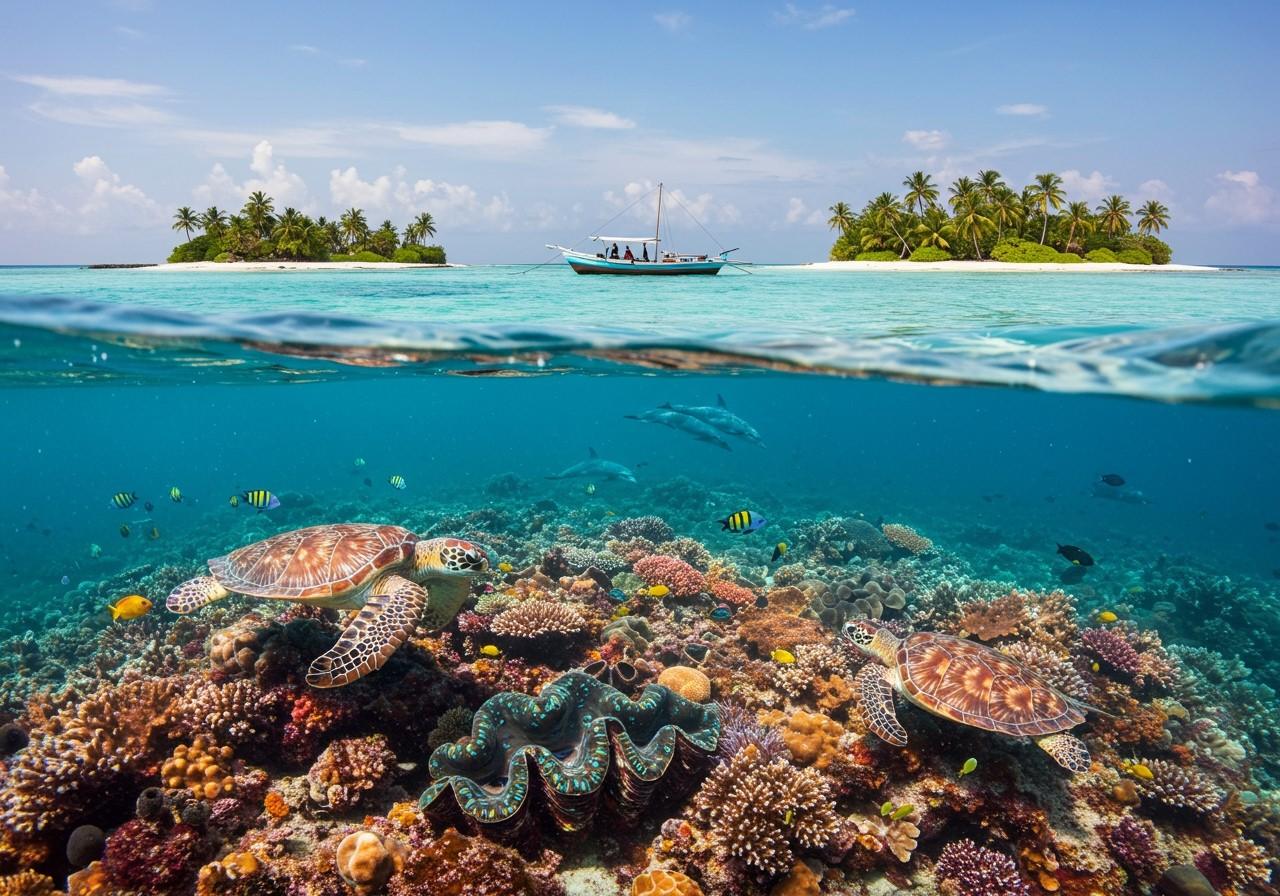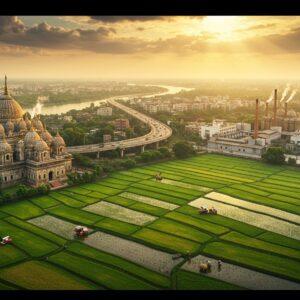
Lakshadweep, a mesmerizing archipelago in the Arabian Sea, is renowned for its captivating natural beauty and diverse ecosystem. Often referred to as a “coral island,” Lakshadweep’s unique environment plays a vital role in supporting both its rich biodiversity and the livelihoods of its inhabitants. Understanding the delicate balance of this ecosystem, encompassing its coral reefs, distinctive flora, and fascinating fauna, is crucial for appreciating the cultural and environmental significance of this region.
Lakshadweep: A Coral Island
Lakshadweep’s classification as a coral island stems from its formation primarily from coral detritus and organic materials. These coral reefs are not merely geological formations; they are the very foundation of the islands, shaping their topography and acting as a natural barrier against coastal erosion and the destructive forces of storms. The reefs provide a vibrant habitat for an array of marine life, establishing Lakshadweep as a biodiversity hotspot. Furthermore, they perform essential ecological functions, including nutrient cycling, and underpin the local economy by supporting fishing and tourism.
Sadly, the coral cover in Lakshadweep has seen a dramatic decline, plummeting from 51.6% in 1998 to a mere 11% in 2017. This alarming loss underscores the urgent need for conservation efforts. The Lakshadweep archipelago, comprising 36 islands in the southern Arabian Sea, represents one of India’s most significant coral reef complexes. These reefs are incredibly productive marine ecosystems, teeming with a diverse array of plant and animal life. Their preservation is paramount, and initiatives focused on protecting the marine ecosystem offer hope for their recovery and long-term conservation.
The Unique Flora of Lakshadweep
Under the tropical sun, Lakshadweep nurtures a unique collection of plant life. Iconic coconut palms sway rhythmically in the ocean breeze, their roots anchoring them firmly to the sandy shores. Breadfruit trees provide welcome shade and sustenance, while the striking pandanus plants add vibrant green hues to the landscape. These resilient species have adapted remarkably to the challenging environmental conditions, demonstrating a remarkable tolerance to the saline environment.
The significance of coconut palms extends far beyond their scenic beauty. They are deeply intertwined with the local way of life, providing essential resources such as coconuts, coir, and toddy, thus supporting the livelihoods of countless families. Every part of the coconut tree finds a valuable use in Lakshadweep. However, this lush vegetation is not without its challenges. Invasive species and the impacts of climate change pose serious threats. Ongoing conservation initiatives are focused on preserving the native flora and ensuring its continued prosperity.
The Diverse Fauna of Lakshadweep
Lakshadweep’s animal life is as captivating as its plant life. Above the waves, majestic birds like the white-bellied sea eagle command the skies, while the brown noddy finds tranquil nesting grounds, adding to the islands’ serene charm. Beneath the surface, a vibrant underwater world unfolds. A multitude of fish, mollusks, and crustaceans find refuge amongst the intricate coral reefs.
These waters also serve as a sanctuary for endangered species such as the hawksbill turtle. Protecting their nesting sites is critical for their survival. Each creature, from the smallest invertebrate to the largest marine animal, plays a crucial role in maintaining the delicate balance of the coral reef ecosystem.
Lakshadweep’s Ecosystem: The Future and Beyond
Lakshadweep’s ecosystem faces formidable challenges, including the impacts of climate change, coral bleaching, and human activities, all of which threaten its delicate balance. However, hope prevails through dedicated conservation efforts. Marine protected areas and sustainable tourism practices aim to safeguard this natural paradise.
Community-led initiatives empower local residents to actively participate in preserving their unique environment. Cutting-edge technologies, such as satellite imaging and the creation of artificial reefs, play an increasingly important role in monitoring coral health and supporting reef restoration. Educational programs are essential for raising awareness and fostering a sense of responsibility among the islands’ inhabitants.
Lakshadweep has the potential to become a shining example of sustainable island management. By prioritizing conservation, it can inspire other regions to protect their invaluable natural treasures. As we look towards 2025 and beyond, these collective endeavors will be instrumental in ensuring that Lakshadweep’s remarkable beauty endures for generations to come.
How Poojn.in Supports Environmental Protection in Lakshadweep
At Poojn.in, we deeply appreciate the sacred connection between nature and Hindu traditions. We recognize that the coral reefs, flora, and fauna of Lakshadweep represent a precious part of Lord Krishna’s divine creation, deserving of our utmost respect and protection. Therefore, we offer a selection of eco-friendly puja items that align with the principles of environmental conservation:
Eco-Friendly Offerings:
- Natural Cotton Wicks: Crafted without harmful chemicals, these wicks minimize pollution during religious ceremonies.
- Pure Copper Vessels: Choose our copper vessels for water offerings, promoting a sustainable alternative to plastic.
- Organic Kumkum and Natural Colors: Opt for natural and biodegradable options for a more environmentally conscious puja.
- Biodegradable Puja Items: Explore our range of biodegradable items to minimize your environmental impact.
Supporting Marine Life Protection:
Our pure copper kalash and vessels offer a sustainable alternative to plastic, reducing plastic pollution that poses a significant threat to Lakshadweep’s delicate coral reefs and marine life. Discover our copper collection and contribute to marine conservation.
Plant-Based Offerings:
- Pure Sandalwood Products: Experience the authentic fragrance of sandalwood with our sustainably sourced products.
- Natural Incense Sticks: Enhance your puja with our natural incense sticks, made with eco-friendly ingredients. Explore our incense selection.
- Organic Cotton Wicks: Choose our organic cotton wicks for a cleaner, more environmentally friendly puja. Find more puja essentials.
- Tulsi Plants and Seeds: Honor the sacred Tulsi plant with our selection of plants and seeds, promoting reverence for nature. Browse our Tulsi offerings.
By choosing these eco-friendly puja items from Poojn.in, devotees can fulfill their religious obligations while actively contributing to environmental preservation. This approach aligns harmoniously with Lord Krishna’s teachings, emphasizing the importance of protecting all living beings and maintaining balance with nature. Visit Poojn.in to explore our complete collection of eco-friendly puja items.
Embracing a Sustainable Future for Lakshadweep
Lakshadweep’s journey towards a sustainable future exemplifies the power of community engagement and a steadfast commitment to conservation. By cherishing the island’s extraordinary flora and fauna and embracing responsible practices, we honor the traditions that connect us to this land. The challenges are substantial, but with collaborative efforts and a deep respect for nature, a brighter future is within reach.
As stewards of this precious ecosystem, we have a shared responsibility to protect and nurture it, ensuring that the coconut palms continue to grace the landscape, the birds soar freely above, and the coral reefs thrive with life. By working together, we can safeguard Lakshadweep’s natural heritage for generations to come. Let us cherish this paradise, not just for today, but for all the tomorrows that await.
Learn more about eco-friendly puja practices and discover how to incorporate sustainable rituals into your life.


